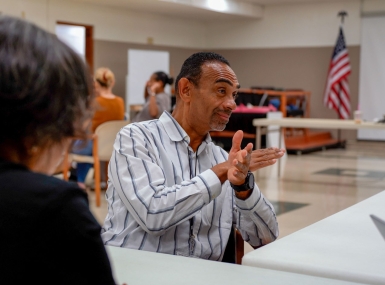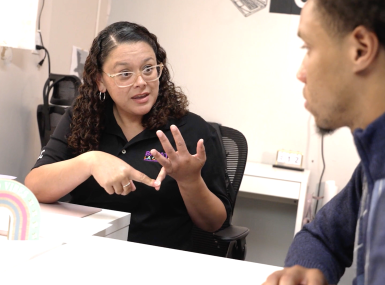BRECC Economic Diversification Toolkit: Guide to Diversify Rural and Transitioning Economies

Upcoming Events
Related News
NACo’s Building Resilient Economies in Coal Communities (BRECC) Economic Diversification Toolkit provides transitioning communities with a roadmap towards diversifying and strengthening local economies. Beginning in 2022, BRECC provided technical assistance to communities impacted by coal industry changes. Grounded in these experiences, NACo’s toolkit supports all counties across the country to prepare for and recover from economic shocks, such as industry downturn, supply chain disruption, consumer demand change or natural disaster.
Jump to Section
- Overview
- Steps to Develop an Economic Diversification Strategy Plan
- Strategies for Economic Diversification
- Program Spotlight: BRECC
Tools to Jumpstart Economic Diversification Planning
Overview
NACo’s Building Resilient Economies in Coal Communities (BRECC) Economic Diversification Toolkit provides transitioning communities with a roadmap towards diversifying and strengthening local economies. Beginning in 2022, BRECC provided technical assistance to communities impacted by coal industry changes. Grounded in these experiences, NACo’s toolkit supports all counties across the country to prepare for and recover from economic shocks, such as industry downturn, supply chain disruption, consumer demand change or natural disaster.
Though planning processes will vary based on a county’s unique needs and resources, communities in NACo’s BRECC initiative generally adhered to the following steps for developing an Economic Diversification Plan:
Step 1 | |
Step 2 | |
Step 3 | |
Step 4 | |
Step 5 | |
Step 6 | |
Step 7 | |
Step 8 |
This content is intended for educational purposes only. The National Association of Counties (NACo) supports policies and programs that equip county governments with the resources and flexibility needed to serve our residents. NACo does not endorse any particular strategy or approach shared in this resource over another. For official NACo positions, please refer to the American County Platform.
Step 1
Assemble the Leadership Team
The first step in developing a county’s economic diversification plan is establishing a leadership team. The appropriate composition of a leadership team will be unique to each locality based on its economic strategies, heritage and existing networks and partnerships. Leadership team members typically include representatives from local organizations, such as:
- County or municipal governments
- Chambers of commerce
- Workforce development boards
- Local businesses
- Religious institutions or faith-based organizations
- Community colleges or other academic institutions
- Artist collectives or creative economy partners
Designating a lead individual or organization on the team helps to coordinate further steps in the planning process. Typically, effective lead organizations have a regional perspective, focus on community-driven priorities, embrace a place-based economic development framework and are trusted actors within the community.
Step 2
Review Existing Plans to Identify Assets and Gaps
Most counties have pre-existing planning documents, such as comprehensive plans, economic development reports or a regional Comprehensive Economic Development Strategy (CEDS), which is created by an Economic Development District (EDD) or Council of Governments (COG).
These pre-existing plans and data sources guide understanding of community assets and needs that can be leveraged to enhance community quality of life and to advance economic development goals. For example, most CEDS plans include a Strengths, Weaknesses, Opportunities and Threats (SWOT) analysis that catalogs past or current strategies and challenges.
Asset Types & Examples
Intellectual
High schools, trade and vocational schools, community colleges, universities, researchers, community development organizations
Social
Rotary clubs, community and civic groups, youth organizations
Cultural
Heritage and cultural clubs, faith-based organizations, museums, art collectives
Natural
Landmarks, parks and recreation areas, scenic landscapes, open space, minerals and other natural resources
Infrastructure
Transportation networks, power transmission lines, broadband access
Financial
Community development organizations, financial institutions, chambers of commerce
Political
County and municipal governments, state government, federal agencies, regional governance bodies
Other
Local businesses, artist collectives, creative economy partners
Tool
Assets Inventory Worksheet
Download the BRECC toolkit’s Assets Inventory Worksheet for examples of asset types and a column to list specific resources available in the local community, making it easy to identify critical gaps.

Step 3
Identify Key Partners and Roles
Partners are essential for conceptualizing, prioritizing and implementing economic diversification strategies. Categorizing partners as local, regional, state or national indicates the partner’s level of community involvement and understanding. The process of clearly defining partner roles often demonstrates where functions, talents and authority may overlap.
Key Roles
Funders
Organizations providing capital such as banks, corporate partners, philanthropies and government entities
Technical Experts
Consultants, researchers, academics and subject-matter professionals offering specialized knowledge and experience
Validators
Trusted community members and groups supporting feedback loops, like parent-teacher associations and local networks
Implementers
Service or training providers, construction firms and planners involved in carrying out initiatives and projects
Advisors
Knowledgeable individuals or groups engaged as thought partners during planning and implementation
Tool
Summary of Potential Partners and Roles
Download the BRECC toolkit’s Summary of Potential Partners and Roles to help categorize the types and roles of partners in economic diversification efforts.
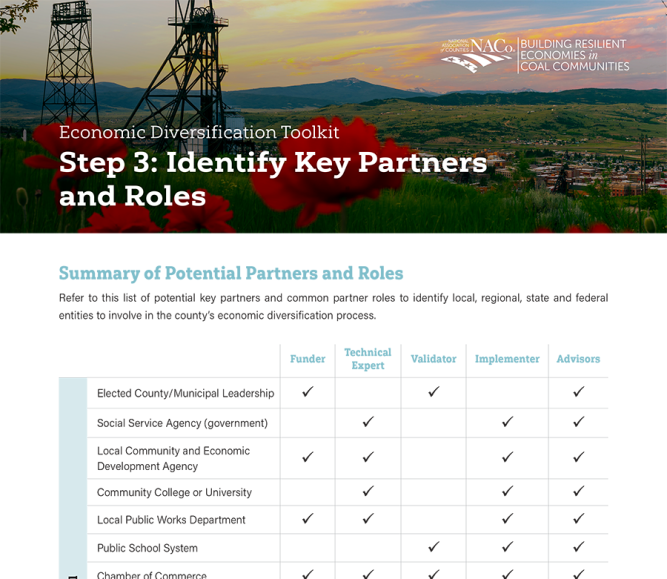
Step 4
Engage the Community
Frequent and deliberate community engagement activities contribute to diversification planning processes by enhancing transparency and trust, breaking down traditional silos and building consensus around a common vision and mission. Continuing engagement activities throughout the planning and implementation process helps to maintain ongoing community participation and awareness.
Although creating new engagement activities may be important to reach isolated constituencies, accessing existing communication channels that are familiar to community members can be especially effective. Some of these existing channels might include:
- Community group meetings or place-based online networks for in-person or virtual inputs or feedback
- Traditional media like local newspapers, radio shows and television newscasts to advertise updates and other engagement opportunities
- Social media accounts that are popular with residents to reach younger community members and neighborhood groups
- Public hearings for residents to voice concerns or support for planned programming
Tool
Community Engagement Activity Options Guide
Download the BRECC toolkit’s Community Engagement Activity Options Guide for more information on several types of engagement activities.
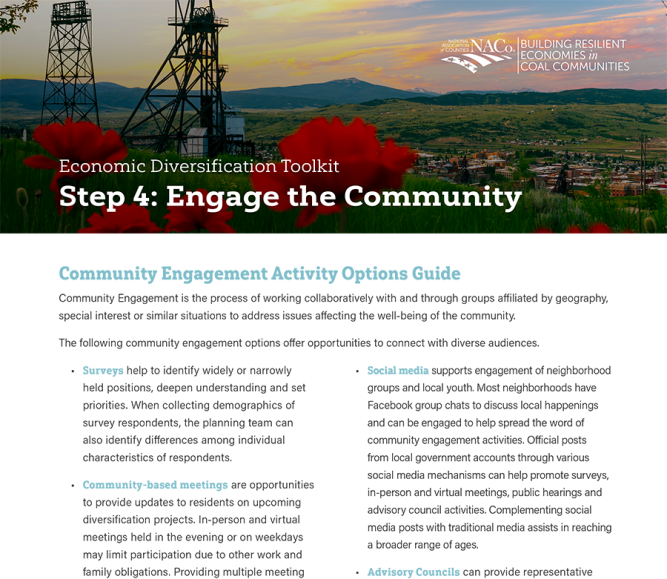
Tool
Community Engagement Action Plan Template
Download the toolkit’s Community Engagement Action Plan Template to develop local activities based on the intended audience, expected results, partners, timeline, resources and barriers.
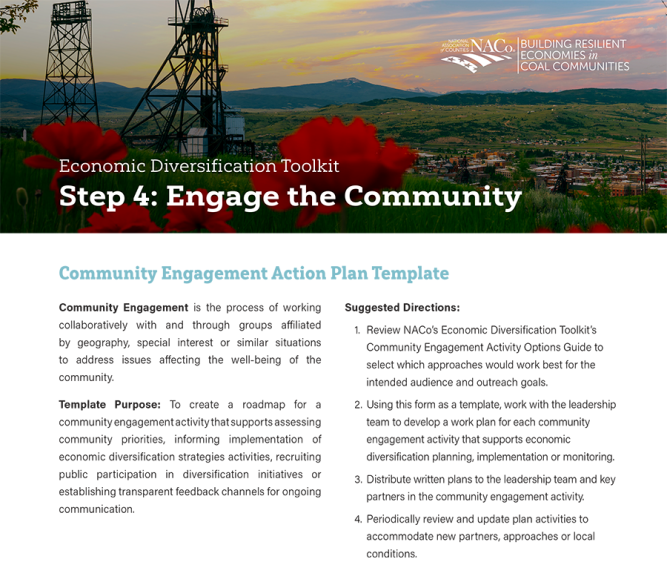
Step 5
Set Strategic Initiatives and SMART Goals
The leadership team can build on its analysis of assets, gaps, key partnership and community input to set strategic initiatives and corresponding SMART goals. Key questions to guide leaders on determining the plan’s strategic initiatives are:
- Will the initiative lead to results that meet community needs, expectations and long-term well-being?
- Does the community have the capacity and resources to support the initiative over time?
- What mechanisms are in place to ensure that the initiative continues to move forward after the initial excitement fades?
- Who are the local investors and implementers who will sustain the initiative activities?
- Who else outside of the community can be engaged to support, promote and invest in this work?
After the strategic initiatives are set, the planning team develops SMART goals for each. SMART goals are:
- Specific to define the exact target population and desired outcome
- Measurable to track and evaluate level of successful outcome
- Achievable to ensure feasibility of the target given local capacity and resources
- Relevant to align with community priorities
- Time-bound to set an explicit deadline
SMART Goal Example for Strategic Initiative to Support Small Businesses
The Southeastern Montana Economic Development Corporation is a regional development organization representing the counties of Custer, Treasure, Powder River and Rosebud. It created this SMART Goal for its new Business Innovation Center, which provides entrepreneurs with workspaces and business support services.
SMART GOAL: Establish a multi-functional professional facility to support small business development and retention by renting co-working spaces to three local businesses by the end of Quarter 1 of the first fiscal year of operation.
Tool
Strategic Options and Timeframe Guide
Download the BRECC toolkit’s Strategic Options and Timeframe Guide for specific examples, organized by short-, medium- and long-term implementation phases.
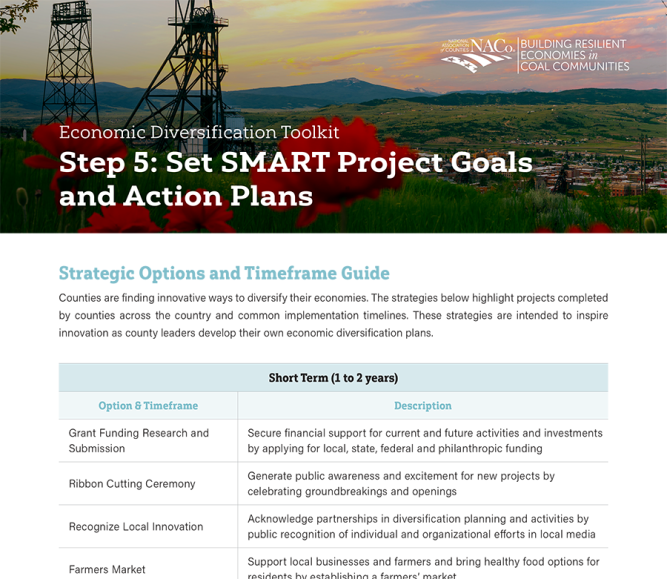
Tool
Economic Diversification Strategies
For examples of strategic approaches implemented by BRECC counties, check out the eight economic diversification strategies below.
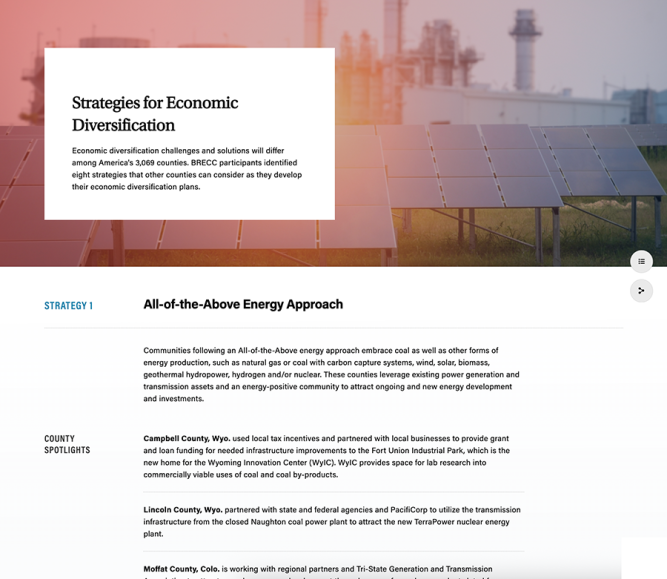
Tool
SMART Goal Setting Guide
Download the BRECC toolkit’s SMART Goal Setting Guide to craft SMART goals for each of the county’s prioritized strategic initiatives.
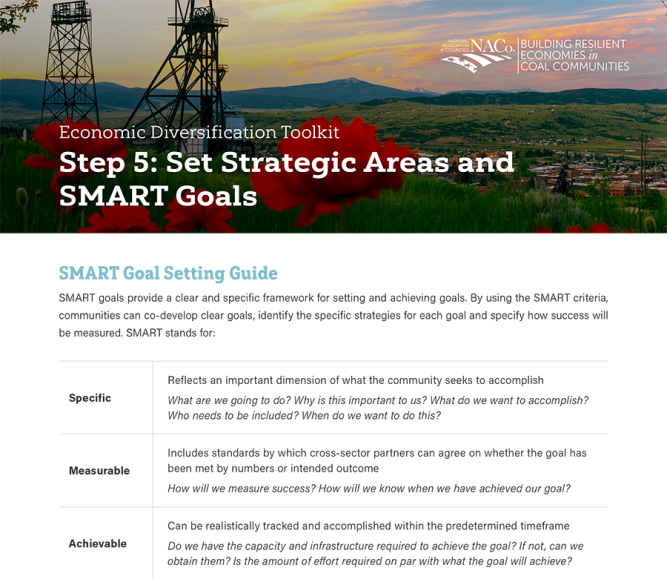
Step 6
Implement the Plan
The implementation stage transforms plans into real results for county residents. Successful implementation requires creating a governance structure to manage progress and emergent conditions throughout implementation. Effective structures differ by community and may be a standalone organization, ad hoc project committee or embedded function within an established organization, such as within an Economic Development District. Regardless of the specific format, typical governance responsibilities for plan implementation include overseeing project execution, coordinating partners, ensuring accountability and securing resources. Throughout implementation, the designated governance body will need to meet regularly and publicly share updates on progress, accomplishments, setbacks and results.
Step 7
Monitor Progress and Results
The governance team takes on the responsibility for monitoring progress towards SMART goals. Goal-specific performance metrics help counties to monitor progress on plan objectives. Reporting on changes in the metrics provides transparency for residents, which can foster greater trust in both the diversification initiatives and leadership. Regular monitoring also assists the team in making timely adjustments to projects throughout implementation.
Performance tracking of a county’s economic diversification plan implementation is especially effective when integrated with county systems. For example, including metrics in county budgets improves adequate and transparent resource allocation. Providing county department leaders and staff with clear goals and metrics tied to their budgets can clarify priorities and boost accountability for SMART goal implementation.
Step 8
Tell the Story
Storytelling plays a crucial role in translating strategies into relatable narratives that engage residents. Some approaches within diversification plans yield results quickly, while others require years to show progress. Recognizing and celebrating small successes along the way is valuable to maintaining public support, investment and engagement.
Storytelling can also help maintain community support. Efforts to diversify local economies may sometimes be met with concern or resistance from residents. Residents may experience concerns regarding their family's well-being or face challenges adapting to changes in their community as established practices shift. Through storytelling, leadership teams can frame diversification efforts as opportunities for local employment, small business growth or valued amenities. Integrating reliable data into these stories can further reinforce public trust.
Examples of mediums that county leaders can utilize to share stories include:
- Local newspapers
- Podcasts
- Regional Council of Governments meetings
- State county associations
- State representative constituent offices
- Social media posts
- County government newsletters
- Booths at community events and fairs
Strategy 1
All-of-the-Above Energy Approach
Communities following an All-of-the-Above energy approach embrace coal as well as other forms of energy production, such as natural gas or coal with carbon capture systems, wind, solar, biomass, geothermal hydropower, hydrogen and/or nuclear. These counties leverage existing power generation and transmission assets and an energy-positive community to attract ongoing and new energy development and investments.
County Spotlights
Campbell County, Wyo. used local tax incentives and partnered with local businesses to provide grant and loan funding for needed infrastructure improvements to the Fort Union Industrial Park, which is the new home for the Wyoming Innovation Center (WyIC). WyIC provides space for lab research into commercially viable uses of coal and coal by-products.
Lincoln County, Wyo. partnered with state and federal agencies and PacifiCorp to utilize the transmission infrastructure from the closed Naughton coal power plant to attract the new TerraPower nuclear energy plant.
Moffat County, Colo. is working with regional partners and Tri-State Generation and Transmission Association to attract new clean energy development through reuse of a coal power plant slated for closure in 2028. Other initiatives include attracting a geothermal energy company and solar demonstration project with state cooperation and federally designated funds.
Tool
Power Generation Comparison Chart
Download the BRECC toolkit’s Power Generation Comparison chart to help determine which energy type is right for your county, including natural gas with carbon capture and storage (CCS), coal with CCS, hydrogen, nuclear, hydropower, biomass, land-based wind and utility solar. (developed by BRECC partner Community Builders)
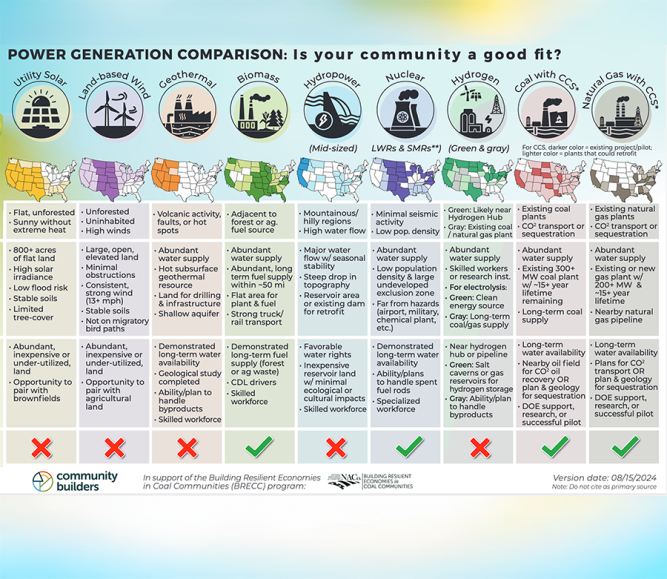
Strategy 2
Outdoor Recreation and Tourism
In rural areas experiencing downturns in the coal economy or other major industries, counties are investing in their natural environments and recreational assets. These investments serve to both boost local economies through tourism and improve local residents’ quality of life.
County Spotlight
Fayette County, W.Va. has expanded its outdoor recreation and tourism industries by working with state and regional partners to successfully advocate for the federal designation of the New River Gorge as a national river in 1978 and a national park in 2021, which greatly increased visitors to these designated areas. The county’s small business sector is thriving as a result, including a local rafting operation that grew into a multifaceted resort and river gear manufacturer and expanded both seasonal and year-round job opportunities.
Strategy 3
Downtown Revitalization and Small Business Support
Coal Communities are renewing downtowns by improving infrastructure, supporting small businesses and repurposing buildings to foster growth. These measures help overcome industrial boom and bust cycles that can leave behind vacant or blighted buildings and displaced workers. County investments to revitalize the built environment and encourage entrepreneurship reinforce locally-driven economic growth.
County Spotlights
Town of Fayetteville in Fayette County, W.Va. has responded to increases in worker and tourist housing demand stemming from the newly designated nearby New River Gorge National Park by redeveloping its historic downtown with new modern apartments and boutique hotel; this development has led to a Tax Incremental Financing district that will fund further capital investments.
Town of Kemmerer in Lincoln County, Wyo. has seen significant reinvestment in businesses and civic facilities on its main street arising from the new Terrapower Nuclear Plant coming to the area, including restoration of the historic opera house, local produce grocer, sidewalk curb cuts for accessible access and beautification projects.
Strategy 4
Strategic Infrastructure Investment
As a first step in encouraging new industrial growth, counties are repairing and replacing essential infrastructure, such as broadband, housing supply, resilient energy sources, ground transportation and wastewater systems.
County Spotlights
Apache, Coconino, Navajo and Yavapai Counties, Ariz. worked with the Northern Arizona Council of Governments and Arizona Public Service utility to build out a broadband loop in their service areas.
City of Richwood in Nicholas County, W.Va. has successfully attracted new downtown businesses after its flood-recovery investments, including restoring roadways, repairing the storm sewer system and upgrading the municipal water and sanitary sewer systems.
Strategy 5
Expanded Housing Supply
Counties invest in a mix of housing options to prevent existing residents from relocating to areas with more affordability and variety. Access to housing for employees is also a major consideration for new companies locating in a region.
County Spotlights
Greenbrier County, W.Va. used disaster relief funds from flooding, allocation of public-owned lands and a mix of housing tax credits to transform a former elementary school into apartments.
Orange and Owen Counties, Ind. streamlined regulatory processes for residential construction that enabled a major manufacturer to develop worker housing to overcome recruitment and retention issues from the area’s tight housing market.
Strategy 6
Workforce Development and Training
Counties are collaborating with workforce development boards and American Jobs Centers to develop local talent and retain young people. This strategy is especially effective in addressing out-migration of populations for better job and education opportunities and skill gaps between existing worker capabilities and employer workforce needs.
County Spotlights
Giles County, Va. entered into a partnership with New River Community College to provide a tuition-free, two-year education for qualifying high school students to prevent young people from leaving the area and to increase youth community involvement through its volunteer requirements.
Webster County, Ky. partnered with the Madisonville Community College with the support of Delta Regional Authority funding to offer a lineman training program on the former Dotiki Coal Mine site, which is leading to high-demand and good job openings. The program meets local worker needs and has attracted trainees from across the U.S.
Strategy 7
Repurposing Former Mine Lands
Coal communities offer readily available land with excellent transportation and energy-related infrastructure to attract new manufacturing and value-added businesses that support larger industries in the area.
County Spotlights
Lewis County, Wash. began investments in county-owned property in the early phases of the local coal powerplant closure. The county has leveraged the resulting Industrial Park at TransAlta, invested $10 million in infrastructure improvements and designated the area as a federal Opportunity Zone, which has attracted power producing industries to the area.
Pike County, Ind. was home to several major mines and power plants. In the wake of these coal industry closures, the Pike County Economic Growth and Development Council is now marketing the area’s rail and road networks and on-site transmission lines and substations as the Southwest Indiana Megasite with 8,000 acres for new industries, such as the ENTEK manufacturing facility for lithium batteries.
Strategy 8
Remote Worker Attraction
Attracting employed remote workers to a county can quickly increase local consumer purchasing power and tax base. Many coal and other rural communities offer a highly desirable outdoor lifestyle that can attract workers when paired with investments in broadband service, co-working spaces and relocation benefits.
County Spotlight
Harlan County, Ky. is part of the Eastern Kentucky Remote’s 33-county worker relocation program that offers financial and social incentives to bring remote workers to eastern Kentucky. Through a partnership with Kentucky General Assembly, Kentucky Power and Shaping Our Appalachian Region, Harlan County hosted the program’s first remote worker.
BRECC Support
BRECC was operated by the National Association of Counties using federal funds under award ED22HDQ3070080 from the Economic Development Administration, U.S. Department of Commerce. The statements, findings, conclusions, and recommendations are those of the author(s) and do not necessarily reflect the views of the Economic Development Administration or the U.S. Department of Commerce.







